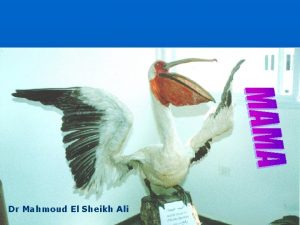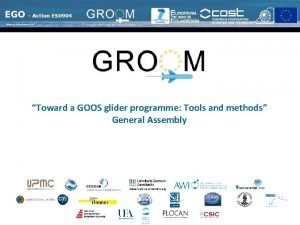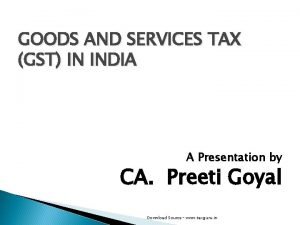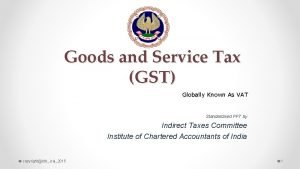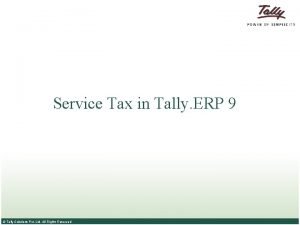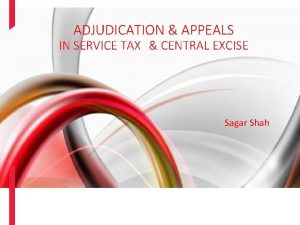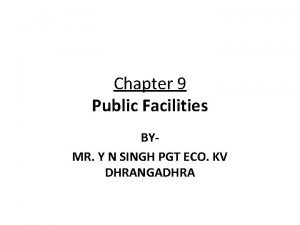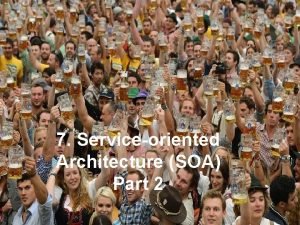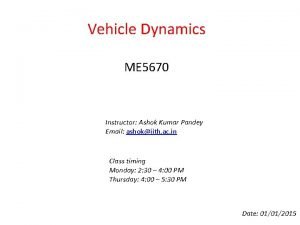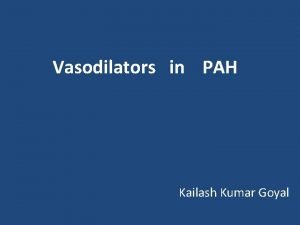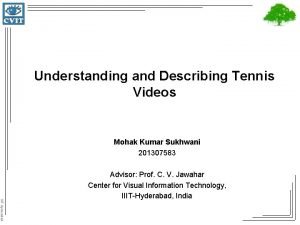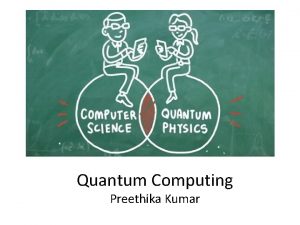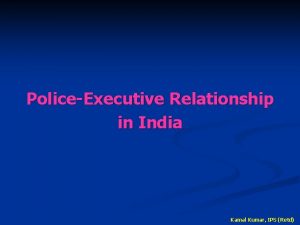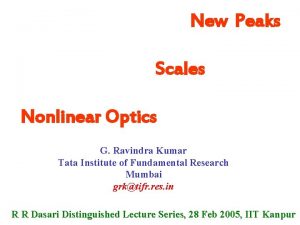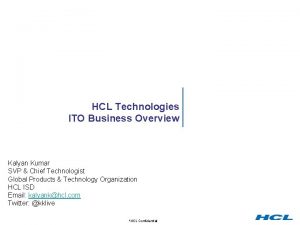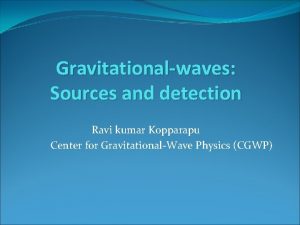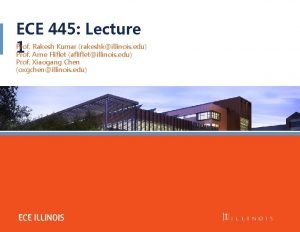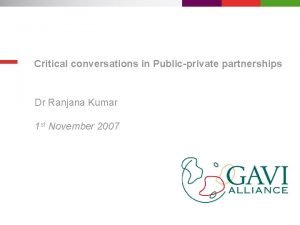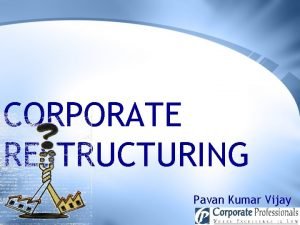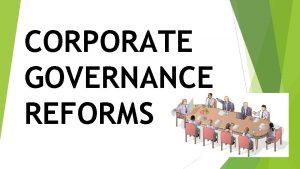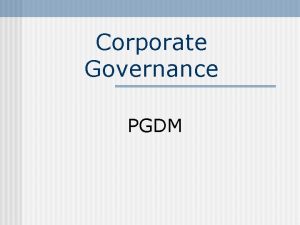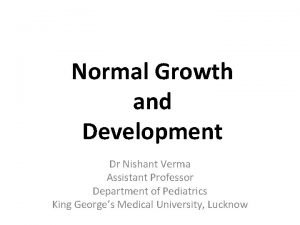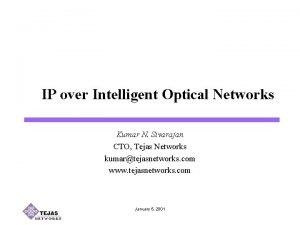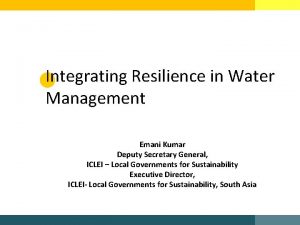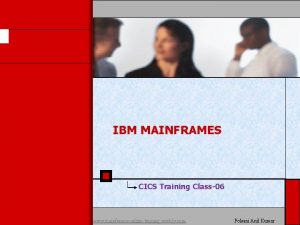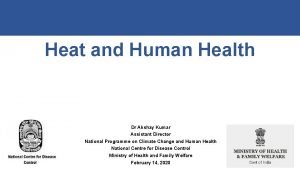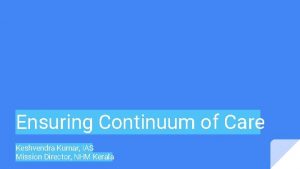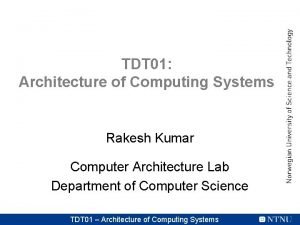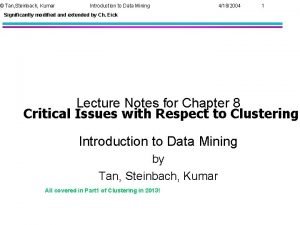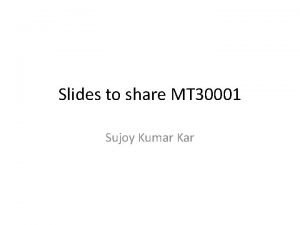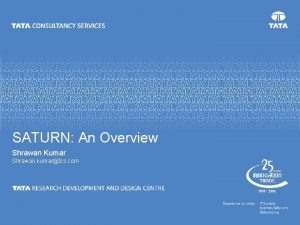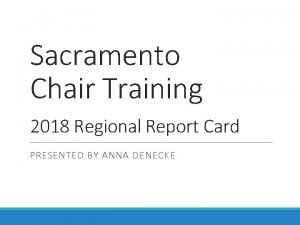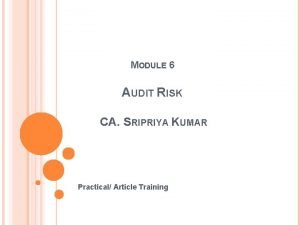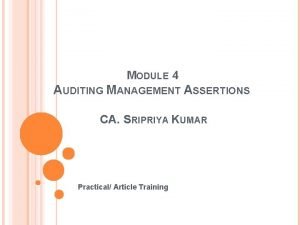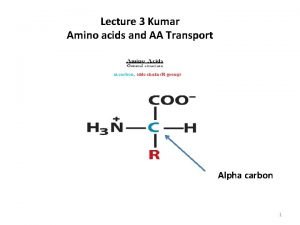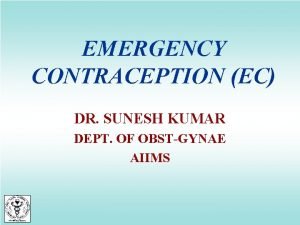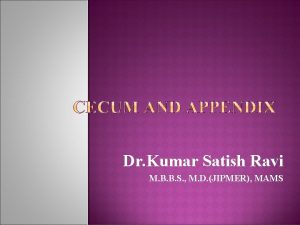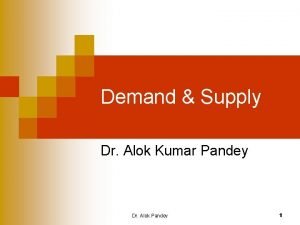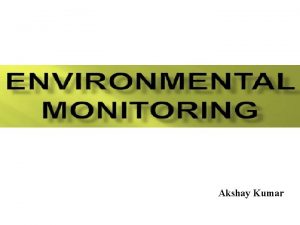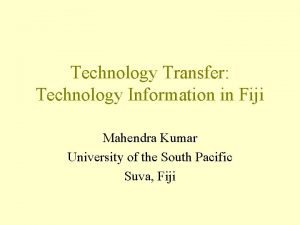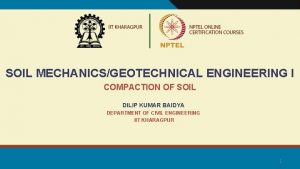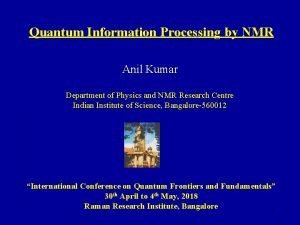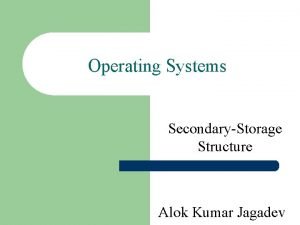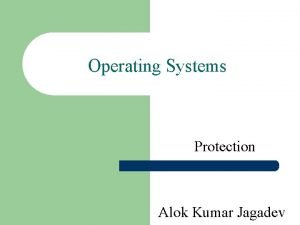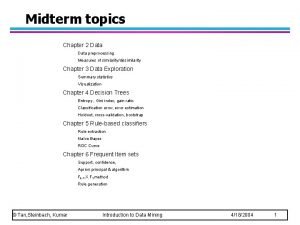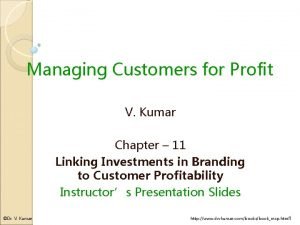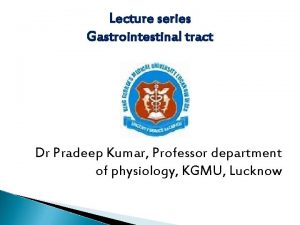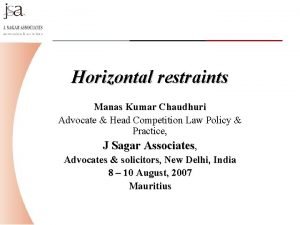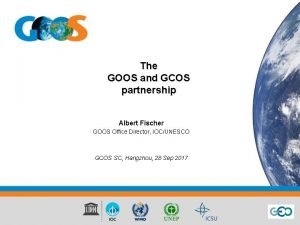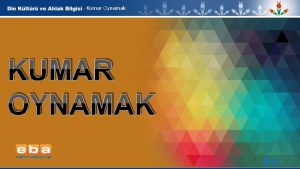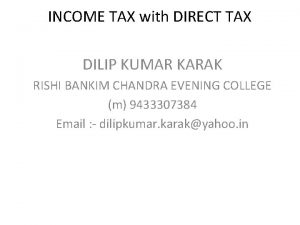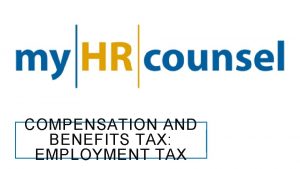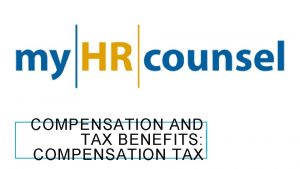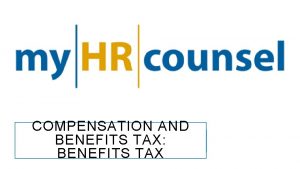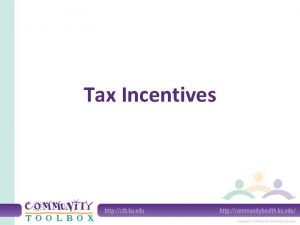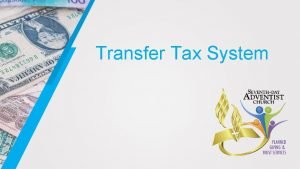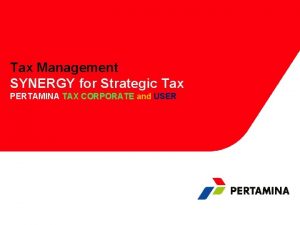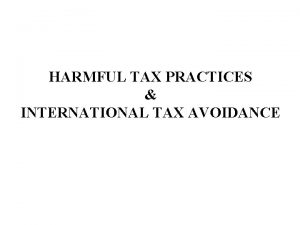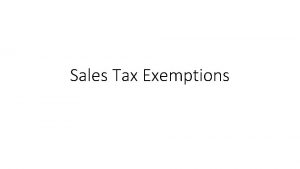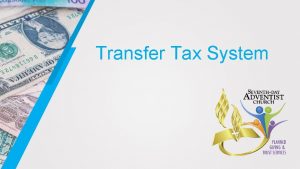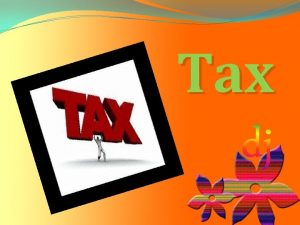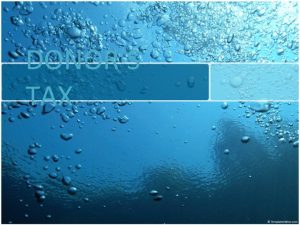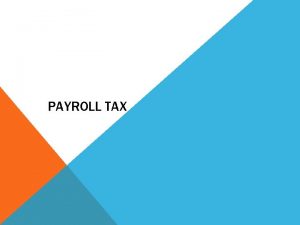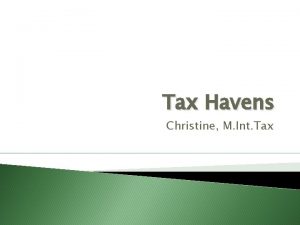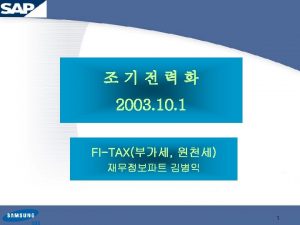OVERVIEW OF GOOS AND SERVICE TAX SUKHJIT KUMAR



































































- Slides: 67

OVERVIEW OF GOOS AND SERVICE TAX SUKHJIT KUMAR ADDITIONAL COMMISSIONER SERVICE TAX, MUMBAI 1

Limitations of Existing Indirect Tax Regime : 1. Too many types of taxes : � Central Taxes 1. Central Excise duty 2. Duties of Excise (Medicinal and Toilet Preparations) 3. Additional Duties of Excise (Goods of Special Importance) 4. Additional Duties of Excise (Textiles and Textile Products) 5. Additional Duties of Customs (commonly known as CVD) 6. Special Additional Duty of Customs (SAD) 7. Service Tax � State taxes : 1. State VAT 2. Central Sales Tax 3. Luxury Tax 4. Entry Tax (all forms) 5. Entertainment and Amusement Tax 6. Taxes on advertisements 7. Purchase Tax 8. Taxes on lotteries, betting and gambling 9. Octroi 2

Limitations of current Tax regime : 2. Multiple Registrations/Multiple Tax Authorities Central Excise

Limitations of current Tax regime : 3. Different Points of Taxation Limitations of current Tax regime : Central Excise (On Manufacturing) Service Tax (On provision of Service) VAT ( On sale of Goods)

Limitations of current Tax regime : 4. Lack of Uniformity No Entry Tax @ NIL % Value Added Tax e. g. on Sugar @ 4%

Limitations of current Tax regime : 5. Goods Vs. Services dilemma ? License Software in CD Sale of Food In Restaurant Sale Services Manufacturing

Cascading Effect of Tax Credit of CST Not Available MP) Credit of Excise not allowed

§ Revenue leakage § Thin Assessee Base § Inter state barriers § Restricted Movement of goods § Regional Disparities 8

� 2000 -FM’s Economic Adviser, Vijay Kelkar – for meeting targets of lower fiscal deficit , increasing revenues suggested that : India should introduce a modern tax law — by shifting the focus from a tax on production to a tax on consumption, and by creating a single national market that would provide a huge boost to Indian manufacturing. 9

� 2004 Finance Minister, P Chidambaram, worked out the financial support to states and campaigned for the introduction of National VAT. After overcoming resistance, by 2005, Chidambaram could announce a national VAT or GST, covering both the Centre and the states to be introduced from 2010. � In 2011, Finance Minister Pranab Mukherjee introduced a Bill to provide the enabling framework for GST. � During that period, resistance to the proposed GST was led by BJP-ruled Madhya Pradesh and Gujarat. � states opposing the new structure also raised the issue of their autonomy being impacted. � Bill was reintroduced in Lok Sabha in 2014 under present Govt 10

Legal Hurdles in GSTFINANCIAL RELATIONS Existing CENTRE-STATE � Currently, the fiscal powers between the Centre and the States are clearly demarcated in the Constitution. � The Centre has the powers to levy tax on the manufacture of goods while the States have the powers to levy tax on the sale of goods. � In case of inter-State sales, the Centre levies the Central Sales Tax but, the tax is collected and retained by States. � As for services, it is the Centre alone that is empowered to levy service tax. � For the Introduction of the GST, the Constitution has been amended so as to simultaneously empower the Centre and the States to levy and collect this tax. 11

CONSTITUTION (122 nd) AMENDMENT BILL , 2014 � The Constitution (122 nd ) Amendment Bill was introduced in Lok Sabha in December, 2014 and was passed by the House in May, 2015. � The said Bill was passed by Rajya Sabha on 3 rd August, 2016. � Ratified � Assam by more than 50% of State legislatures. became the first state to ratify the GST BILL on 12 th August, 2016 � Received Presidential assent on 8 th Setember, 2016 � Enacted as Constitution (One Hundred and First Amendment) Act, 2016. 12


GST One Tax For Manufacturing Trading Services ONE NATION: ONE TAX

A single tax would replace multiple taxes. GST would replace following taxes & duties levied and collected by the Centre: 1. Central Excise duty 2. Duties of Excise (Medicinal and Toilet Preparations) 3. Additional Duties of Excise (Goods of Special Importance) 4. Additional Duties of Excise (Textiles and Textile Products) 5. Additional Duties of Customs (commonly known as CVD) 6. Special Additional Duty of Customs (SAD) 7. Service Tax 8. Central Surcharges and Cesses so far as they relate to supply of goods and services 15

State taxes that would be subsumed under the GST are: 1. State VAT 2. Central Sales Tax 3. Luxury Tax 4. Entry Tax (all forms) 5. Entertainment and Amusement Tax (except when levied by the local bodies) 6. Taxes on advertisements 7. Purchase Tax 8. Taxes on lotteries, betting and gambling 9. State Surcharges and Cesses so far as they relate to supply of goods and services 16

SALIENT FEATURES OF GST : � The GST would be applicable on the supply of goods or services. � It would be a destination based consumption tax. � It would be a dual GST with the Centre and States/Union Territories simultaneously levying it on a common tax base. � The GST to be levied by the Centre would be called CENTRAL GOODS & SERVICE TAX (CGST) and that to be levied by States/UTs would be called STATE GOODS & SERVICE TAX (SGST)/ Union Territory Tax (UTT) � An INTEGRATED GOODS & SERVICE TAX (IGST) would be levied and collected by the Centre on Inter-State supply of goods and services. 17

SALIENT FEATURES OF GST : � The GST shall be levied on all goods and services except alcoholic liquor for human consumption � Petroleum & petroleum products would be subject to GST. But Five petroleum products – Petroleum Crude , HSD, Motor Spirit (Petrol), Natural Gas & Aviation Turbine Fuel(ATF)would be out of GST in initial years of implementation. � In the case of Tobacco and Tobacco Products, the Centre could levy excise duty in addition to GST. � Taxes on entertainments and amusements to the extent levied and collected by a Panchayat/Municipality/Regional Council/District Council shall not be subsumed under GST. 18

SALIENT FEATURES OF GST ( Contd. ) � An Integrated GST (IGST) would be levied and collected by the Centre on inter-State supply of goods and services. Tax payers shall be allowed to take credit of taxes paid on inputs (Input Tax Credit) at every stage. Which would mitigate the ill effects of cascading. � CGST credit can be used for payment of CGST and SGST credit can be used for payment of SGST. � � No ITC on account of CGST shall be utilized towards payment of SGST and vice versa. � Credit of IGST would be permitted to be utilized for payment of IGST, CGST and SGST in that order. � SGST portion of IGST shall be transferred to the destination State where the goods or services are eventually consumed. 19

SALIENT FEATURES OF GST (Contd. ) � HSN code shall be used for classifying the goods under the GST regime. � Taxpayers whose turnover is above Rs. 1. 5 crores but below Rs. 5 crores shall use 2 -digit code and the taxpayers whose turnover is Rs. 5 crores and above shall use 4 -digit code. � Exports and supplies to SEZ shall be treated as zero-rated supply. No tax is payable on exports but ITC related to the supply shall be refunded to exporters. � Import of goods/services would be subject to IGST in addition to customs duties. 20

INCIDENCE OF TAX CGST/SGST (Sec-9) (1) Central Goods and Services Tax /State Goods and Services Tax (CGST/SGST) shall be levied on all intra-State supplies of goods and/or services at such rates as may be notified by the Central/State Government in this behalf on the recommendation of the Council and collected in such manner as may be prescribed , but not exceeding TWENTY percent. (2) The CGST/SGST shall be paid by every taxable person in accordance with the provisions of this Act. (3) On certain categories of supply of goods and/or services the tax will be paid on reverse charge basis by the recipient of such goods and/or services 21

Supply by unregistered persons: The central tax in respect of the supply of taxable goods or services or both by a supplier, who is not registered, to a registered person shall be paid by such person on reverse charge basis as the recipient and all the provisions of this Act shall apply to such recipient as if he is the person liable for paying the tax in relation to the supply of such goods or services or both. 22

INCIDENCE OF TAX- IGST (Sec-5 IGST ACT) Section 5 : Integrated Goods and Services Tax on all supplies of goods and/or services made in the course of inter-State trade or commerce at such rates as may be notified by the Central/State Government in this behalf on the recommendation of the Council and collected in such manner as may be prescribed but not exceeding FORTY percent On certain categories of supply of goods and/or services the tax will be paid on reverse charge basis by the recipient of such goods and/or services On certain categories of services the tax shall be paid by the electronic commerce operator if such services are supplied through it. 23

GST COUNCIL MEETING HELD ON 3. 11. 2016 FINALISED GST RATE STRUCTURE : 5% 12% 18% 24

MEANING AND SCOPE OF SUPPLY : Sec. 7 Under GST regime, tax is payable on the supply of goods and/or services. (1) Supply includes all forms of supply of goods and/or services such as sale, transfer, barter, exchange, license, rental, lease or disposal made or agreed to be made for a consideration by a person in the course or furtherance of business, (b) importation of services, for a consideration whether or not in the course or furtherance of business, and 25

Supply of Goods or Services : 2 6 § “Goods’’ means every kind of movable property other than money and securities but includes actionable claim, growing crops, grass and things attached to or forming part of the land which are agreed to be severed before supply or under a contract of supply; � ‘Supply of goods’ means the transfer of right to dispose off tangible property as owner which means the transfer of both title to the goods and possession of, or control over, the goods � Supply includes sale, transfer, barter, exchange, license, rental, lease or disposal

Supply of Services. . 2 7 “services’’ means anything other than goods; q‘Supply of services’ means supply which is not a supply of goods, made for consideration which may include grant, assignment or surrender of any right, assignment of intangible property, obligation to refrain from or tolerate an act, lease, hire, right to access any premises etc. q. A supply of service is said to be made when a person does something, or agrees to do something for a consideration. A supply of service is also said to be made when a person agrees to refrain from doing something or gives up a right for consideration which also includes grant, assignment or surrender of any right.

GST on Supply of Goods & Services : 2 8 § GST is a multi-stage tax levied on supply of goods and/or services, collected at each stage of the production and distribution, in proportion to the value added by each taxable person in the chain of supply. § In the GST regime, the entire value of supply of goods and/or services is proposed to be taxed in an integrated manner, unlike the existing indirect taxes, which are charged independently either on the manufacture or sale of goods, or on the provisions of services. § In a nutshell, only value addition will be taxed and burden of tax is to be borne by the final consumer.

GST -SUPPLY CHAIN 2 9

GST- SUPPLY CHAIN 3 0 § Supply A State A Manufacturer to Dealer for Rs. 2000 [CGST @ 10% ] [SGST @ 10%] CGST- 200 SGST- 200 § Supply B Dealer to Retailer for Rs 3000 STATE-B IGST @20% (ITC § Supply C 600 200 +200 ) (ITC 600) Retailer to Consumer for Rs 4000 CGST- 400 SGST- 400

composite or a mixed supply Sec-8 The tax liability on a composite or a mixed supply shall be determined in the following manner — (a) a composite supply comprising two or more supplies, one of which is a principal supply, shall be treated as a supply of such principal supply; (b) a mixed supply comprising two or more supplies shall be treated as supply of that particular supply which attracts the highest rate of tax. 31

Neither Goods nor Services !!! � The following would not constitute supply of Goods or Services (Schedule –III of the Act) Øby an employee to employer ØServices by any Court or Tribunal ØFunctions performed by Members of Parliament/ State legislature/Panchayats/ Municipalities/ other local authorities. ØDuties performed by Constitutional functionary. ØDuties performed by Chairperson/Member /Director in a body of CG/SG/local authority, who is not deemed to be an employee before commencement of this clause.

Neither Goods nor Services !!! (Contd. ) ØFuneral, burial, crematorium/mortuary service, including transportation of deceased ØSale of land ØSale of building[ subject to clause (b) of paragraph 5 of Schedule II) ØActionable claims, other than lottery, betting and gambling

Who will pay GST – THE TAXABLE PERSON (1)Taxable Person means a person who is registered or liable to be registered under Section 22 or 24 the Act. Liability to be registered : ØEvery person who is registered or who holds a license under an earlier law ØEvery person whose turnover in a Financial Year in a state exceeds Rs. 20 lakhs [10 Lakh for special category states ] 34

The following persons shall not be liable to registration, namely: –– ( a) ) any person engaged exclusively in the business of supplying goods or services or both that are not liable to tax or wholly exempt from tax under this Act or under the Integrated Goods and Services Tax Act; (b ) an agriculturist, to the extent of supply of produce out of cultivation of land. (2) The Government may, on the recommendations of the Council, by notification, specify the category of persons who may be exempted from obtaining registration under this Act. 35

REGISTRATION “aggregate turnover” means the aggregate value of all taxable supplies (excluding the value of inward supplies on which tax is payable by a person on reverse charge basis), exempt supplies, exports of goods or services or both and inter-State supplies of persons having the same Permanent Account Number, to be computed on all India basis but excludes central tax, State tax, Union territory tax, integrated tax and cess; � 36

Compulsory Registration Section-24 § Liability to be registered irrespective of threshold limit : Ø Persons making inter-State taxable supply Ø Persons required to pay tax under reverse charge Ø Casual and non-resident taxable persons Ø E-Commerce operator Ø Persons who supply goods through e-commerce operator Ø Person making taxable supply of goods and/or services on behalf of other taxable person as an agent or otherwise Ø every person supplying online information and database access or retrieval services from a place outside India to a person in India, other than a registered taxable person; Ø Input Service Distributor Ø Persons required to deduct tax at source u/s 51 ( Tax Deduction at source) and Section 52 ( Collection of tax at source) 37

REGISTRATION. . Contd. §A person, though not liable to be registered, may take registration voluntarily. §Registration to be granted State-wise. A person having multiple business verticals in a State may obtain separate registration §UN agencies, Multilateral Organizations, Embassies etc. shall be granted a Unique Identity Number instead of registration 38

COMPOSITION SCHEME � Taxpayers with an aggregate turnover in preceding FY did not exceed Rs. 75 lakhs (50 lakh) shall be eligible for composition levy. � Under the scheme, a taxpayer shall pay tax as a percentage of his turnover in a state /UT during the year without the benefit of ITC. � � 2% of the Turnover in case of manufacturer 5 % for Restaurants 1 % in case of other supplies A tax payer opting for composition levy shall not collect any tax from his customers and will not be entitled for input tax credit 39

Composition Scheme: Followings taxable person are not eligible for composition scheme: (a) who is engaged in the supply of services other than supplies referred to in clause (b) of para 6 of Schedule II ; or (b) who makes any supply of goods which are not leviable to tax under this Act; (c) who makes any inter-State outward supplies of goods; or (d) who makes any supply of goods through an electronic commerce operator who is required to collect tax at source under section 52; or (e) who is a manufacturer of such goods as may be notified on the recommendation of the Council: � No composition duty for a taxable person unless all the registered taxable persons, having the same PAN as held by the said taxable person, also opt to pay tax under the provisions of this sub-section. 40

INPUT TAX CREDIT(ITC) Key feature of GST is its uninterrupted and continuous chain of input tax credit (ITC). � Presently cascading of tax is significant due to non-availability of ITC at various stages. E. g ITC of CST, Entry Tax, Luxury Tax is not available. Similarly ITC of VAT is not available to manufacturers and service providers and ITC of Central Excise duty, service tax & CVD is not admissible to dealers in goods. � � Section 16 -Every registered taxable person shall , be entitled to take credit of input tax charged on any supply of goods or services to him which are used or intended to be used in the course or furtherance of his business and the said amount shall be credited to the electronic credit ledger of such person: 41

INPUT TAX CREDIT(ITC) Sec. 16 ITC is available in respect of all taxable supplies of all goods & services. But no ITC in respect of the following : (a) motor vehicles except when they are used for : (i) transportation of passengers, or (ii) transportation of goods, or (iii) imparting training on motor driving skills; (b) goods and / or services provided in relation to food and beverages, outdoor catering, beauty treatment, health services, cosmetic and plastic surgery, membership of a club, life insurance, health insurance etc. when such goods and/or services are used primarily for personal use or consumption of any employee; 42

INPUT TAX CREDIT(ITC) (c) works contract services when supplied for construction of immovable property, other than plant and machinery, except where it is an input service for further supply of works contract service; (d) goods or services received by a taxable person for construction of an immovable property on his own account, other than plant and machinery, even when used in course or furtherance of business; e) goods and/or services on which tax has been paid under section 10; (f) goods and/or services used for personal consumption; (g) goods lost, stolen, destroyed, written off or disposed of by way of gift or free samples; and (h) any tax paid in terms of sections 74, 129 or 130. Full ITC shall be allowed on capital goods on receipt 43

INPUT TAX CREDIT. . Contd. Conditions for availing of ITC by taxable person: Øhe is in possession of a tax invoice Øhe has received the goods and/or services Øthe tax charged in respect of the supply has been paid to Government Øhe has furnished the return Ø ITC cannot be availed on invoices which are more than one year old. 44

INPUT TAX CREDIT. . Contd. Manner of utilization of credit • ITC on account of CGST shall first be utilized towards payment of CGST; the amount remaining, if any shall be utilized towards payment of IGST • ITC on account of SGST shall first be utilized towards payment of SGST; the amount remaining, if any shall be utilized towards payment of IGST. • No ITC on account of CGST shall be utilized towards payment of SGST and vice versa. • ITC on account of IGST shall first be utilized towards payment of IGST; the amount remaining, if any shall be utilized towards payment of CGST and SGST, in that order. 45

RETURN---Chapter VIII § Taxpayers shall file monthly returns. Return to be filed within 20 days after the end of tax period. § Composition taxpayers shall file quarterly returns. ITC shall be provisionally allowed on filing of return. § Short-filing of return is allowed, but returns filed without payment of full tax shall not be treated as a valid return for allowing ITC in respect of supplies made by taxable person. § Annual return to be filed on or before 31 st December following the end of the financial year 46

INVOICE MATCHING Sec. 29 & 29 A § After filing of return by the taxable person, his inward supplies § and/or debit notes shall be matched with the corresponding outward supplies and/or debit notes declared by the supplier in his tax return. In case of matching, the ITC claimed by the taxable person shall be finally accepted and he shall be informed. § In case of mis-match, the discrepancy shall be notified to the taxable person and his supplier. § Where the supplier does not rectify the discrepancy in his return, the amount to the extent of discrepancy shall be added to the output tax liability of the taxable person. 47

INVOICE MATCHING. . Contd. § Likewise, the reduction in tax liability due to issue of a credit note by the supplier shall be matched with the reduction in ITC claimed by the recipient in his return. § In case of matching, such reduction in the tax liability shall be finally accepted and communicated to the supplier. § In case of mis-match, the discrepancy shall be notified to the supplier and the recipient. § Where the recipient does not rectify the discrepancy and reduce his ITC claim in his return, the amount to the extent of discrepancy shall be added to the output tax liability of the supplier. § A taxable person can reclaim the ITC reversed only after the concerned supplier furnishes the details of invoice and/or debit note in his return. 48

PAYMENT OF TAX § Every deposit made by a taxable person shall be credited to the Electronic Cash Ledger of such person § ITC as self assessed in the return of a taxable person shall be credited to his electronic credit ledger § § Payment of tax is made by way of the debit in the electronic cash or credit ledger Taxable person shall discharge his liability in the following order Ø Self-assessed tax, and other dues related to returns of previous tax periods; Ø Self-assessed tax, and other dues related to returns of current tax period; and Ø any other amount payable under the Act or rules made there under including the demand determined under section 73 &74. 49

REFUNDS § Refund can be claimed within 2 years from the relevant date. § Refund of ITC allowed in case of exports or where the § § § § credit accumulation is on account of inverted duty structure. (other than nil rated or exempted supplies) Refund shall be granted within 90 days from the date of receipt of application. In case of refund claim on account of exports, 90% of the claim can be given immediately on a provisional basis. Presumption of passing of of incidence of tax- Applicant shall produce documentary evidence that he has not passed on the incidence of tax on to any other person. No need to furnish such evidence if the refund claim is less than Rs. 5 lakhs. Self-certification would suffice. Interest payable after 90 days from the date of receipt of application till the date of refund. Refund of ITC not allowed where the export goods are subject to duty. No ITC refund if supplier avails drawback in respect of CGST of claims refund of IGST paid on such supplies 50

ASSESSMENT-Sec. 57 Self Assessment: Taxable person shall himself assess the taxes payable Provisional assessment -Taxable person may request for provisional assessment in cases where he is unable to determine the value or rate of tax � Taxable person will have to furnish bond and security for availing this facility. � Provisional assessment is to be finalized within 6 months � After final assessment, the taxable person shall be liable to pay additional tax or may claim refund, as case may be 51

DEMANDS Sec 73 & 74 § SCN or Statement Of Demand for tax not paid or short paid of erroneous refund or wrongly availed ITC § Adjudication order shall be issued within 3 years of filing of annual return in § § § normal cases ---10 Thousand or 10% penalty. SCN to be issued 3 month before the above period of adjudication order The time limit is 5 years (from filing of annual return) in fraud/suppression cases. SCN to be issued 6 month before the above period of adjudication order. Provisions for settlement of cases at every stage, right from audit/investigation to the stage of passing of adjudication order and even thereafter. No/Minimal penalty if the tax and interest is paid at the stage of audit/investigation. The officer shall in his order set out the relevant facts and the basis of his decision. The amount of tax, interest and penalty demanded in the order shall not be in excess of the amount specified in the notice. No demand shall be confirmed on grounds other than the grounds specified in the notice. 52

TAX COLLECTED BUT NOT PAID TO THE GOVERNMENT: Sec. 76 § § § Any amount collected as tax from customers shall be paid to Govt. regardless of whether the supplies are taxable or not. If not paid, SCN shall be issued ----No time limit. The proper officer shall, after considering the representation if any, determine the amount. The person concerned shall pay tax along with interest right from the day the tax was collected till the date of payment. The proper officer shall issue the order within 1 year from the date of issue of SCN. The person who has ultimately borne the incidence of tax may apply for refund as per the provisions of Sec. 38. 53

SEARCH, SEIZURE AND ARREST Sec. 69 �Power to search places and seize goods, documents etc. has been retained under GST law. �After seizure of goods, if notice not is given within 6 months , the goods shall be returned to the person. The period is extendable up to 6 months. �A person can be arrested only where the amount of tax evaded exceeds Rs. 2. 5 Crore or where it is a repeat offence. �If the amount of tax evaded exceeds Rs. 5 crore, the offence is cognizable and nonbailable. �Commissioner is competent to order arrest 54

PROSECUTION Sec. 132 OFFENCES PUNISHMENT § Amount of tax evaded exceeds 5 years imprisonment plus fine § Amount of tax evaded exceeds Rs. 3 years imprisonment plus fine Rs. 5 crore, and repeat offences. 2. 5 Crore but does not exceed Rs. 5 crore. § Amount of tax evaded exceeds § Rs. 100 lakhs but does not exceed Rs. 2. 5 crore. Abets or commits an offence under cl f, g and j 1 year imprisonment plus fine 6 months imprisonment plus fine 55

OTHER CRITICAL PROVISIONS § E-commerce companies would collect and pay to the § government, out of the amount payable to the supplier of goods, tax at the notified rate. Central/State Govt. departments, local authorities and governmental agencies to deduct tax @ 1% from the payment made to the supplier where the total value of supply under a contract exceeds Rs. 2. 5 lakhs § Transporter of goods carrying a consignment of value more than 50, 000 to carry with him documents or devices as may be specified for verification by tax authorities. 56

GST LAW: HIGHLIGHTS. . Contd. � � Anti-profiteering Measure (sec 171) The Central Government may by law constitute an Authority, to examine whether input tax credits availed by any registered taxable person or the reduction in the price on account of any reduction in the tax rate have actually resulted in a commensurate reduction in the price of the said goods and/or services supplied by him. Exports and Supplies to SEZ shall be treated as zero rated supply. No tax is payable on exports but credit of the input tax related to that supply shall be admissible and the same can be claimed as refund by them. � Imports to be taxed at the same rate as integrated tax (IGST) levied on inter-State supply of like domestic products (CVD) � JOB WORK ---The facility of job work has been continued under the GST. 57

GST COUNCIL A GST Council has been constituted comprising the Union Finance Minister, MOS (Revenue) and the State Finance/Taxation Ministers to recommend on: Ø the taxes, cesses and surcharges to be subsumed under GST; Ø goods and services that may be subjected to or exempted from GST; Ø date from which the specified petroleum products would be subject to GST; Ø model GST laws, principles of levy, apportionment of IGST and principles that govern the place of supply; Ø threshold limit of turnover below which the goods and services may be exempted from GST; 58

GSTN: The IT Backbone of GST a. 70 to 80 Lakhs taxpayers; b. 260 to 300 Crores B 2 B invoice data per month c. More than 120, 000 tax officials to work d. Monthly filing of returns e. Credit of ITC f. Creation of Business Intelligence reports and Analytics g. Both Central and States Tax Departments • • Strong IT Infrastructure Independent Flexibility of Pvt Sector Strategic Control of Govt 59

GSTN a. Non-Government, Private Limited company b. Provide common Registration, Return filing and e-Payment services to the taxpayers c. Ensure integration of the GST Common Portal with existing tax administration systems of Central / State Governments and other stakeholders d. To run the clearing-house mechanism for IGST amongst c Centre and s States e. Provide Analytics and Business Intelligence to tax authorities f. Carry out research, study best practices and provide training to the stakeholders 60

�Presently, there around 160 countries that have implemented GST/VAT in some form or other. �In some countries it is called VAT but conceptually it is a destination based tax levied on consumption of goods and services. �Only Canada has dual GST model Just like India is going to implement Dual GST Model). 61

BENEFITS OF GST Uniform Taxe all over India The list of exempted goods and services would be common for the Centre and the States. � � Ø Tax burden on goods and services would decrease, benefiting common man. Ø Implementation of GST would make our products competitive in domestic and international markets. Ø It would boost economic activity and create more jobs. Ø The GDP would grow though the estimates in this regard vary. 62

Benefits of GST � Robust and Comprehensive IT system would be the foundation of the GST. � GSTN � Registration, Returns, Payments , Refunds etc will be on line � Minimum interface between the Taxpayer and Tax Authorities � Tax compliance will be transparent and easy

Benefits of GST Common Man Reduction in Overall Tax Payout Reduction in Prices Clarity and Transparency � Business Man Single Tax Compliance Hassle Free No cascading of Taxes No Ambiguity � Government(s) Revenue Increase Easy Administration No Revenue Leakage Better tax compliance Increase in Tax base One unified National Market Easier movement of goods from one state to other No barriers �

CONCLUSION GST : A Game Changer � Introduction of GST would be a very significant step in the field of indirect tax reforms in India. � Revenues of Centre and States would rise due to widening of tax base, increase in trade volumes and improved tax compliance. � Introduction of GST would reduce economic distortions caused by inter. State variations in taxes. � It will streamline tax administration and avoid harassment of business. � Compliance costs for the industry will go down. � The GST, because of its transparent nature, would be easier to administer. � It would pave the way for a common national market. 65

FOR HELP ON GST MATTERS �www. cbec. gov. in �www. gst. gov. in � cbecmitra. helpdesk@icegate. gov. in : for migration issues Ø Helpline toll free number: 1800 -1200 -232 � CBEC GST Mobile App at Google Play Store 66

Sukhjit Kumar sukhjit 001@hotmail. com 67
 Sukhjit singh de anza
Sukhjit singh de anza Goos online
Goos online Mama goos
Mama goos A goos
A goos Gst percentage in india
Gst percentage in india Roland purcell a technical writer
Roland purcell a technical writer Role of gst
Role of gst App service overview
App service overview Service tax in tally erp 9
Service tax in tally erp 9 Cbic service tax login
Cbic service tax login Public facilities relate to people's
Public facilities relate to people's Adequate service expectations examples
Adequate service expectations examples Evolution of soa
Evolution of soa Ashok kumar pandey iit hyderabad
Ashok kumar pandey iit hyderabad Goyal definition
Goyal definition Mohak sukhwani
Mohak sukhwani Bryn mawr computer science
Bryn mawr computer science Xshhz
Xshhz Kamal kumar ips
Kamal kumar ips G ravindra kumar
G ravindra kumar Kalyan kumar hcl
Kalyan kumar hcl Ravi kumar kopparapu
Ravi kumar kopparapu Uiuc ece 445
Uiuc ece 445 Ranjana kumar gavi
Ranjana kumar gavi Pavan kumar vijay
Pavan kumar vijay Kumar mangalam birla committee
Kumar mangalam birla committee Kumar mangalam birla committee
Kumar mangalam birla committee Dr anuj kumar tripathi neurosurgeon
Dr anuj kumar tripathi neurosurgeon Kumar venkitanarayanan
Kumar venkitanarayanan Kumar is producing the photoelectric effect by using
Kumar is producing the photoelectric effect by using Kumar raj kharel
Kumar raj kharel Dr nishant verma gastroenterologist
Dr nishant verma gastroenterologist Kumar n. sivarajan
Kumar n. sivarajan Emani kumar
Emani kumar Weebly sql database
Weebly sql database Akshay kumar assistant
Akshay kumar assistant Dr v kumar
Dr v kumar Keshvendra kumar ias
Keshvendra kumar ias Dr pulin kumar gupta
Dr pulin kumar gupta Rohtash kumar vs state of haryana
Rohtash kumar vs state of haryana Rakesh kumar ntnu
Rakesh kumar ntnu Tan steinbach kumar
Tan steinbach kumar Jay kumar kar
Jay kumar kar Senthil kumar palanisamy
Senthil kumar palanisamy Shrawan kumar tcs
Shrawan kumar tcs Ravi kumar sacramento
Ravi kumar sacramento Santosh kumar swain kiit
Santosh kumar swain kiit Ca sripriya kumar
Ca sripriya kumar Sripriya kumar
Sripriya kumar Kumar
Kumar Dr v kumar
Dr v kumar Dr. pradip kumar khastagir
Dr. pradip kumar khastagir Dr sunesh kumar
Dr sunesh kumar Kumar satish ravi
Kumar satish ravi Dr alok kumar pandey
Dr alok kumar pandey Akshay kumar
Akshay kumar Mahendra kumar fiji
Mahendra kumar fiji Dilip kumar
Dilip kumar Ibmqx
Ibmqx Bedford interview skills
Bedford interview skills Alok kumar jagadev
Alok kumar jagadev Alok kumar jagadev
Alok kumar jagadev Chapter 9 kumar steinbach tan
Chapter 9 kumar steinbach tan Kumar
Kumar Life of pi true story
Life of pi true story Prof. dr. pradeep kumar gupta
Prof. dr. pradeep kumar gupta Pyelomyotomy
Pyelomyotomy Manas kumar chaudhuri
Manas kumar chaudhuri


